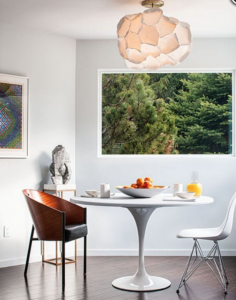We talked at length with interior designer Asler Valero and we learned, among other things, the importance of understanding the psychology behind a homeowner’s vision.
Rosenberg: What do homeowners NOT want?
Valero: When a designer is hired, he might have his own vision and not listen fully to what the client wants. This is a very major issue for a client. They usually want someone to help them achieve their vision, or maybe polish their ideas.
Good interior design is about bringing the client’s goal and vision into alignment with design principles.
As an example, once I was decorating an apartment on the Upper West Side. The client wanted to be very savvy about his spending because he was selling the apartment down the road. And he had all his own ideas about where the dollars should go.
The place had a big, beautiful window facing Broadway, but there was a built-in radiator obstructing it. So, I said, “Let’s spend the money to remove this radiator.”
It was an old building and the windows needed to be updated anyway, which would increase the value of the property. It also increased the light in the apartment dramatically. It made all the difference and it was something the client didn’t give a thought to.
When I’m done with a project, I want the home to match the client’s vision with my touches. I will always do what my client wants, but sometimes I show them something they hadn’t thought of. For example, I present them with the idea of using different textures of fabric or I give them a way to soften the gold they originally wanted.
If I really think something they want isn’t going to work, it keeps me up at night. I’ve actually said, “Let me paint the wall THIS color instead, and if you really hate it, I’ll pay for the painter to do it again.” They always end up loving it.
As much as I want to please my clients, I know that every home I design is a reflection of my work and I want it to be beautiful.
Rosenberg: What do homeowners have the most questions about?
Valero: During the planning process, clients always want to maximize their space, especially storage space in the kitchen and bathroom.
I’d rather see you go with IKEA cabinets and invest in quality appliances and countertops. This creates a very luxe space. As a designer, you must be resourceful and always seek out the best prices.
Rosenberg: What are you seeing in terms of interior technology trends?
Valero: Music and television are very important to homeowners today.
Usually the wife doesn’t want to see a big TV, but the husband does. We must please them both. Sometimes we can hide the electronics in a beautiful cabinet or invest in a TV that looks like a piece of art.
We try to work magic and sometimes become a psychologist in these cases!
Rosenberg: What is typically overlooked in planning a new property?
Valero: There’s always something that needs to be tweaked during the process. Most often it’s the lead time.
So, we have to manage expectations. Underestimating the time you spend on a project happens often because you’re depending on many other people… the contractors, cabinet makers, the upholsterer. Sometimes you’re working with 30+ vendors to get a job done.
For example, to cover one sofa, you’re choosing fabric, having the fabric treated, working with an upholsterer and then waiting for delivery. That’s four, sometimes more, vendors for one piece of furniture.
Rosenberg: How do you ease the stress of coordinating all of this?
Valero: We always create a very detailed purchase order with as much information as we can possibly get.
I have a chart for each room with measurements, pictures and samples. Every detail is specified there, including the vendors I’m using. That way, when a delivery comes, say with fabric, I know whether it’s right or wrong.
Also, I’ve learned that measuring doors is very important. If you order a sofa that doesn’t fit through the front door, you are in big trouble.
Rosenberg: What challenges do you have with technology such as automated window treatments?
Valero: Window treatments, as you know, require special attention to detail.
When there are many layers to deal with, we must know which gets installed first — the solar shade or the blackout shade? The rod and brackets must be installed perfectly to accommodate everything. Is it recessed or side mounted? There are many variables to manage. And we’re talking about one window.
Are you renovating your home? Contact norman@roseintech.com for advice about how to pull it all together.

